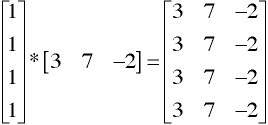
How to turn a vector into a matrix
This is the same method we used to create the mean matrix in Mean Vectors and Matrices.
Consider the Vector v



mat v = (3,7,-2)
mat u = J(4,1,1)
mat X = u*v
mat lis X
X[4,3]
c1 c2 c3
r1 3 7 -2
r2 3 7 -2
r3 3 7 -2
r4 3 7 -2
Dividing Column Elements
In this example we will divide the elements in Column 1 by 2 and the elements in Column 2 by 3.
Consider the Matrix X

Create a Vector with Division Elements

Create a Diagonal Matrix of the Elements of v

Take the Inverse of the Diagonal Matrix

Compute X * D-1

mat X = (4,9\10,12\2,9)
mat v = (2,3)
mat list v
v[1,2]
c1 c2
r1 2 3
mat D = diag(v)
mat list D
symmetric D[2,2]
c1 c2
c1 2
c2 0 3
mat D = syminv(D)
mat list D
symmetric D[2,2]
c1 c2
c1 .5
c2 0 .33333333
mat Q = X*D
mat list Q
Q[3,2]
c1 c2
r1 2 3
r2 5 4
r3 1 3
/* quick way with one command */
mat Q2 = X*syminv(diag(v))
mat list Q2
Q2[3,2]
c1 c2
r1 2 3
r2 5 4
r3 1 3
Compute the Square Root of the Elements of a Diagonal Matrix
Stata & Mata Side-by-side
Stata Mata
mat D = (64,0,0\0,144,0\0,0,20) : D = (64,0,0\0,144,0\0,0,20)
mat list D : D
symmetric D[3,3]
c1 c2 c3
r1 64
r2 0 144
r3 0 0 20
mat S = cholesky(D) : S = sqrt(D)
mat list S : S
symmetric S[3,3]
c1 c2 c3
r1 8
r2 0 12
r3 0 0 4.472136
Using Stata
mat C = (7, -2.5\-2.5,1)
mat list C, title(covariance matrix)
symmetric S[2,2]: covariance matrix
c1 c2
c1 7
c2 -2.5 1
mat S = diag(vecdiag(C))
mat S = cholesky(S)
mat list S /* diagonal matrix of standard deviations */
symmetric S[2,2]
c1 c2
c1 2.6457513
c2 0 1
mat R = syminv(S)*C*syminv(S)
mat list R
symmetric R[2,2]
c1 c2
c1 1
c2 -.94491118 1
Now for the really fast way.
mat R = corr(C)
mat list R
symmetric R[2,2]
c1 c2
c1 1
c2 -.94491118 1
mat X = (32)
mat list X
symmetric X[1,1]
c1
r1 32
display "X = ", X
X = type mismatch
/* using the el function */
scalar x = el(X,1,1)
display "x = ", x
x = 32
/* also try this */
scalar z = X[1,1]
display "z = ", z
z = 32
/* matrix Y must exist */
mat Y = (0)
mat list Y
symmetric Y[1,1]
c1
r1 0
mat Y[1,1] = x
mat list Y
symmetric Y[1,1]
c1
r1 32
Using Stata
mat X = (3,9,17,24\7,8,11,25\6,5,13,29\4,7,15,32\7,9,13,24\8,8,1,23\7,9,12,23)
mat list X
X[7,4]
c1 c2 c3 c4
r1 3 9 17 24
r2 7 8 11 25
r3 6 5 13 29
r4 4 7 15 32
r5 7 9 13 24
r6 8 8 1 23
r7 7 9 12 23
mat u2=(1,0,0\1,0,0\1,0,0\0,1,0\0,1,0\0,0,1\0,0,1)
mat list u2
u2[7,3]
c1 c2 c3
r1 1 0 0
r2 1 0 0
r3 1 0 0
r4 0 1 0
r5 0 1 0
r6 0 0 1
r7 0 0 1
/* compute column sums for each group */
mat t=u2'*X
mat list t
t[3,4]
c1 c2 c3 c4
c1 16 22 41 78
c2 11 16 28 56
c3 15 17 13 46
/* compute the n for each group */
mat n = u2'*u2
mat list n
symmetric n[3,3]
c1 c2 c3
c1 3
c2 0 2
c3 0 0 2
/* compute column means for each group */
mat m = syminv(n)*t
mat list m
m[3,4]
c1 c2 c3 c4
c1 5.3333333 7.3333333 13.666667 26
c2 5.5 8 14 28
c3 7.5 8.5 6.5 23
/* compute mean matrix containing the column means for each group */
mat M = u2*m
mat list M
M[7,4]
c1 c2 c3 c4
r1 5.3333333 7.3333333 13.666667 26
r2 5.3333333 7.3333333 13.666667 26
r3 5.3333333 7.3333333 13.666667 26
r4 5.5 8 14 28
r5 5.5 8 14 28
r6 7.5 8.5 6.5 23
r7 7.5 8.5 6.5 23
Stata & Mata Side-by-side
Stata Mata mat x = (3\6\9\8\4\8\6\7) : x = (3\6\9\8\4\8\6\7) mat y = (4\4\5\6\5\6\7\5) : y = (4\4\5\6\5\6\7\5) scalar n = rowsof(x) : xy = x,y mat u = J(n,1,1) /* deviation scores */ mat x = x - u*((u'*x)/n) mat y = y - u*((u'*y)/n) mat xy = x,y /* variance-covariance matrix */ mat cov = (xy'*xy)/(n-1) mat c = corr(cov) : c = correlation(xy, 1) display c[2,1] : c[1,2] .41753744 .4175374443
Multivariate Course Page
Phil Ender, 15jul07, 27oct05, 11oct05, 30Jun98